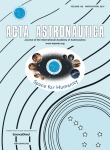Journal
Please choose volume & issue:
-
NASA's eXploration Systems and Habitation (X-Hab) Academic Innovation Challenge
Abstracts:Future exploration missions in the space between the Earth and the Moon or beyond will require complex operational activities to ensure that crew, cargo, and exploration systems safely reach their destination. Through the eXploration Systems and Habitation (X-Hab) Academic Innovation Challenge, NASA develops strategic partnerships and collaborations with universities to increase knowledge in technologies, capabilities, and operational approaches related to future human spaceflight missions. X-Hab activities help NASA bridge strategic knowledge gaps, better understand technology risk reduction, and combine the innovative approaches and diverse insights of university teams with unique agency expertise.
-
CGR-BF: An efficient contact utilization scheme for predictable deep space Delay Tolerant Network
Abstracts:In this paper we propose a scheme that uses the fragmentation scheme of bundle protocol for efficient utilization of contacts between nodes so as to increase the goodput in deep space networks. The node (e.g., planets/satellites/Orbiters) positions in deep space are predictable and messages are transmitted from one node to the other in a store-and-forward mode whenever these nodes are in contact with each other.
Contact Graph Routing (CGR) has been proposed for interplanetary networks due to its delay tolerant nature and characteristics. The CGR chooses a single path between a source and a destination node to achieve the best delivery time of a bundle. However, the contacts that cannot transmit one complete bundle or have some leftover capacity after transmitting one or more complete bundles are ignored here. This leads to wastage of deep space transmission opportunities which are significant. In this paper, we propose a scheme for utilizing these contacts efficiently by fragmenting the bundles wherever possible. The bundle fragments are then routed to the destination using multiple paths. Simulation studies show that CGR-BF efficiently exploits the network's bandwidth and substantially increases the goodput incurring minimum overhead compared to that of the CGR where fixed size bundles are used. -
Analysis and reduction of skin-friction in a rocket-based combined-cycle engine flow path operating from Mach 1.5 to 6.0
Abstracts:The skin-friction in a rocket-based combined-cycle engine operating from Mach 1.5 to 6.0 was analyzed in the present study. The friction proportion of different parts of the engine was investigated to offer a reference for the rearrangement of skin-friction reduction in the engine. The distribution and variation trend of the skin-friction in the flow path as well as its impacts on the engine performance were numerically compared. At three typical flight points, i.e. at 1.8Ma, 3.0Ma and 6.0Ma, the change of the skin-friction with attack angle was studied. A special focus was placed on the reduction of the skin-friction by using boundary layer combustion. It was modeled when the airstream flowed into the engine at the speed of 6 Ma. The method of hydrogen combustion in boundary layer has achieved 57.7% skin-friction reduction effect.
-
Trajectory design and guidance for landing on Phobos
Abstracts:While common Descent and Landing strategies involve extended periods of forced motion, significant fuel savings could be achieved by exploiting the natural dynamics in the vicinity of the target. However, small bodies are characterised by perturbed and poorly known dynamics environments, calling for robust autonomous guidance, navigation and control. Airbus Defence and Space and the University of Bristol have been contracted by the UK Space Agency to investigate the optimisation of landing trajectories, including novel approaches from the dynamical systems theory, and robust nonlinear control techniques, with an application to the case of a landing on the Martian moon Phobos.
-
Form-finding of deployable mesh reflectors using dynamic relaxation method
Abstracts:In this paper, a novel numerical form-finding method is presented based on a dynamic relaxation algorithm for cable nets in mesh reflectors. To obtain a shape with high profile efficiency, structural forces are assumed to be constant values during the computational iterations, so a perfectly uniform distribution of structural forces can be achieved. An initial shape, normally not in equilibrium, is given in advance, and nodes of the network are forced to vibrate by the unbalanced forces. Parameters of dynamic relaxation algorithms, such as the type of damping and the time interval, are tested to ensure the speed and stability of the computation process. Finally, two different types of Astromesh reflectors are used as examples to verify the developed method.
-
Guaranteeing prescribed performance for air-breathing hypersonic vehicles via an adaptive non-affine tracking controller
Abstracts:This paper investigates a prescribed performance control strategy for air-breathing hypersonic vehicles (AHVs) based on neural approximation. Different from the existing studies, the explored controllers are derived from non-affine models instead of affine ones. For the velocity dynamics, an adaptive neural controller containing only one neural network (NN) is addressed via prescribed performance control. Specially, the altitude dynamics is transformed into a pure feedback non-affine model instead of a strict feedback one. Then a novel adaptive neural controller is exploited without using back-stepping. Also, only one NN is utilized to approximate the lumped unknown nonlinearity of the altitude subsystem. By the merit of the minimal-learning parameter (MLP) scheme, only two learning parameters are required for neural approximation. The highlights are that the proposed control methodology possesses concise control structure and a low computational cost and moreover it can guarantee the tracking errors with prescribed performance. Finally, simulation results for an AHV model are provided to demonstrate the efficacy of the proposed control approach.
-
Disturbance rejection dynamic inverse control of air-breathing hypersonic vehicles
Abstracts:This paper presents a disturbance rejection controller for air-breathing hypersonic vehicles (AHVs) based on the technique of nonlinear dynamic inverse (NDI). An observer is employed to estimate the lumped disturbance on the nominal dynamics of AHVs, such as the external disturbances introduced by the changeable flight environment and the unsteady scramjet operation. With the help of this observer, an effective NDI controller is proposed to suppress the negative effect of the lumped disturbance on output channels. Under the proposed control, the input-to-state stability of the closed-loop AHV system can be ensured if the observer gain matrix is properly selected. A simulation study on the disturbed AHV model is provided to illustrate the effectiveness of this disturbance rejection NDI control.
-
Curing of large prepreg shell in solar synchronous Low Earth Orbit: Precession flight regimes
Abstracts:We investigate the curing of large shell construction made of epoxy resin/carbon fibers prepreg under free space conditions in solar synchronous Low Earth Orbit. The curing kinetics is described by first order kinetic equation with auto-acceleration and deceleration parameters based on the experimental data. Heating of the shell is provided by solar radiation. The heat distribution in the shell is modelled based on partial absorbance of the solar radiation, the prepreg thermal conductivity and thermal capacity, radiation heat transfer between inner surfaces of the shell and the gas thermal conductivity. The iterated algorithm of curing was developed. Three flight regimes based on the circular motion of a construction have been considered: 1 – the axis of a shell lies in the tangent plane to the orbit and makes a constant angle with the tangent; 2 – under conditions (1), a shell rotates around its axis with a constant angular velocity; 3 – under conditions (2), the axis of the shell precesses around the tangent to the orbit. It was found, that the parameters of the motion (i.e. angular velocity of the rotation around the axis, precession angular velocity and precession angle) could be optimised in such way, that the whole shell can be completely cured under the solar radiation.
-
Numerical simulations of radiative heat effects in a plasma wind-tunnel flow under Mars entry conditions
Abstracts:The Mars atmosphere, consisting mainly of CO
2 , with a few percent of N2 and other trace gases, is of interest to future space projects. Entry into its gaseous shell is of current significant research interest. For this application, an arc jet driven plasma wind tunnel is available to simulate relevant entry conditions for the planet. Recent improvements and qualification of the test facility, enables the testing on earth of high enthalpy flows with CO2 rich compositions. In order to complement the experimental analysis, numerical simulations of the test facility running at relevant ambient pressures of 600–1000 Pa, corresponding to low altitudes, have been completed. The simulations used a density-based Navier Stokes solver and non-equilibrium chemical and thermal effects which are characteristic of these types of high enthalpy flows. Special interest is given to the radiative heat transfer mechanism. Under these high temperature conditions, radiative effects become more relevant and advanced radiation models must be used. The coupling between the Navier Stokes and radiative transfer equations favours the understanding of plasma wind tunnel flows. The radiative heat is estimated using the k-distribution spectral model, which is appropriate for non-homogeneous radiating media. The numerical results and measurements are compared in order to improve the analysis methods for Mars entry flows. -
Aerodynamics and flight mechanics activities for a suborbital flight test of a deployable heat shield capsule
Abstracts:MINI-IRENE is the Flight Demonstrator of IRENE, a new-concept capsule with a variable geometry, originally conceived by ASI to widen the range of available platforms to retrieve payloads and/or data from low Earth orbit. The main characteristics of IRENE is the “umbrella-like" deployable front structure that reduces the capsule ballistic coefficient, leading to acceptable heat fluxes, mechanical loads, stability and final descent velocity. Following the feasibility studies carried out since 2011, with also preliminary Thermal Protection System materials tests in plasma wind tunnels, the objective is now to design and build a Flight Demonstrator and a Ground Demonstrator to prove, with a suborbital flight and with a Plasma Wind Tunnel (PWT) test campaign, the functionality of the deployable heat shield. The Flight Demonstrator shall be included as a secondary payload in the interstage adapter of a VSB-30 launcher from ESRANGE, then ejected during the ascent phase of the payload section, perform a 15-min ballistic flight, re-enter the atmosphere and hit the ground. The Ground Demonstrator, representative of the Thermal Protection System of the Flight Demonstrator, shall be instead exposed to a heat flux similar to that expected for an atmospheric re-entry from low Earth orbit inside the SCIROCCO Plasma Wind Tunnel at CIRA. The paper, after a short description of the mission profile both for orbital and suborbital flights, focuses on the aerodynamics and flight mechanics activities held for the suborbital flight and PWT test campaigns.
Hot Journals
- Risk Breakdown Matrix for Risk-Based Inspection of Transportation Infrastructure Projects
- Social Control in Outsourced Architectural and Engineering Design Consulting Projects: Behavioral Consequences and Motivational Mechanism
- 2022 Best Paper Award
- Hold-Ups and Failures in Negotiated Order: Unearthing the Nuances of Rework Causation in Construction
- Prevalence and Risk Factors for Poor Mental Health and Suicidal Ideation in the Nigerian Construction Industry
- CFRP–Cable-Stayed Bridge Hybrid with Partial Suspension and a Span Exceeding 3,000 m: Concept, Optimization, and Construction
- Impact of Wind Load Characteristics on Computed Bridge Stay-Cable Forces Used for Bridge Health Monitoring
- Weak-End and Frequency Detection of Elastically Supported Bridges by Contact Residual Response of Two-Axle Test Vehicle in a Round Trip
- Development of Performance-Based Fragility Curves of Coastal Bridges Subjected to Extreme Wave-Induced Loads
- An Analytical Model to Evaluate Short- and Long-Term Performances of Post-Tensioned Concrete Box-Girder Bridges Rehabilitated by an Ultrahigh-Performance Concrete Overlay
- Three-Dimensional Velocity Distribution in Straight Smooth Channels Modeled by Modified Log-Law
- Experimental Investigation on Flow Past Two and Three Side-by-Side Inclined Cylinders
- An Experimental Investigation of Rotor–Box Aerodynamic Interaction 1
- Modeling Gas–Liquid Flow Between Rotating and Nonrotating Annular Disks
- Entry Length Requirements for Two- and Three-Dimensional Laminar Couette–Poiseuille Flows
Advanced Materials (3,745)
- Structured Perovskite Light Absorbers for Efficient and Stable Photovoltaics
- Strategies for High‐Performance Solid‐State Triplet–Triplet‐Annihilation‐Based Photon Upconversion
- Atomic Engineering Catalyzed MnO2 Electrolysis Kinetics for a Hybrid Aqueous Battery with High Power and Energy Density
- Crystal Adaptronics: Global Performance Indices for Dynamic Crystals as Organic Thermal Actuators (Adv. Mater. 20/2020)
- Enlightening Materials with Photoswitches
Acta Astronautica (1,768)
- Mixed-integer trajectory optimization with no-fly zone constraints for a hypersonic vehicle
- Adaptive control design for active Pogo suppression of large strap-on liquid launch vehicles
- Machine learning based approach for modeling and forecasting of GPS–TEC during diverse solar phase periods
- Effect of two-dimensional micro-cavity surface on hypersonic boundary layer
- Investigation on burning behaviors of aluminum agglomerates in solid rocket motor with detailed combustion model








 User Center
User Center My Training Class
My Training Class Feedback
Feedback





